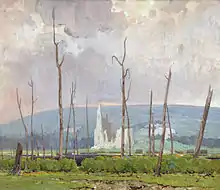John William Beatty
John William Beatty (also known as J. W. Beatty) RCA (1869–1941) was a Canadian painter[1] who was a forerunner in the movement which became the Group of Seven in 1920.
John William Beatty | |
|---|---|
| Born | John William Beatty May 20, 1869 |
| Died | October 4, 1941 (aged 72) Toronto, Ontario |
| Nationality | Canadian |
| Education | Central Ontario School of Art and Design, Toronto (1894); Académie Julian, Paris (1900); London Chelsea Polytechnic, London, England (1906) |
| Known for | painter, teacher at Ontario College of Art (1912-1941) |
| Spouse(s) | Caroline Cornock |
| Elected | Royal Canadian Academy of Arts, Associate member (1903), Full member(1913); Ontario Society of Artists (1901); Arts and Letters Club, President (1912-1913) |
Early Painting Life

Beatty was born in 1859 and went to school in Toronto, Ontario.[2] He was a member of the volunteers who served in the Riel Rebellion in 1885, then worked in the Toronto Fire Department (1869–1900).[3] In his leisure time, he studied art with George Agnew Reid and other teachers.[3] In 1900, he studied at the Académie Julian in Paris with Jean-Paul Laurens and Benjamin Constant.[4] He travelled throughout Europe from 1906 to 1909, painted at the Académie Julian and Colarossi, and travelled to London where he attended the London Chelsea Polytechnic.[3] He made trips to Holland, Belgium and other places to sketch and worked up the sketches when he returned home into many dark, rich, moody paintings of Dutch peasant life and other subjects.[5]
Paintings of Algonquin Park were becoming a theme of Canadian painters in the early years of the Twentieth century. In 1909, the year he returned to Canada, he went to the park in order to paint Canadian landscape themes. He painted The Evening Cloud of the Northland in 1910, a view of a forest fire burning in distant hills.[6] Beatty felt that this work represented Canada much better than his previous work called A Dutch Peasant, so he asked the National Gallery if they would exchange the two because, as he explained, "I am a Canadian. I would much rather be represented by a Canadian picture."[7] The Evening Cloud of the Northland is considered a masterpiece and is in the collection of the National Gallery of Canada.
Influences
Beatty shared common interests and feelings with his friends, Lawren Harris, A.Y. Jackson, Tom Thomson, and Arthur Lismer, several of whom later became members of the Group of Seven. In 1917, he worked as an Official War Artist for the Canadian Expeditionary Force [8] but became aghast at the destructive power of modern warfare.[9]
Public Collections
- Art Gallery of Ontario, Toronto[10]
- Art Museum at the University of Toronto[11]
- Government of Ontario Art Collection, Toronto;[12]
- National Gallery of Canada, Ottawa[13]
Notes
- Benezit Dictionary of Artists
- Bradfield, Helen (1970). Permanent Collection. Toronto: McGraw Hill. ISBN 0070925046. Retrieved June 23, 2020.
- MacDonald 1967, p. 30.
- Bradfield 1970, p. 14.
- Reid, Dennis R. (1988). A Concise History of Canadian Painting, p. 139.
- AMICA Library (Art Museum Image Consortium Library), The Evening Cloud of the Northland, 1910.
- Reid, p. 140.
- Art Gallery of Ontario, "Canvas of War: Masterpieces from the Canadian War Museum," October 2001-January 2002.
- Lloydlangston, A. (2014). Canadian Art of the First World War: Witness. Ottawa: Canadian War Museum. p. 85. Retrieved August 5, 2020.
- Bradfield 1970, p. 14-17.
- MacDonald 1967, p. 31.
- Challener, F. S.. "Government of Ontario art collection database". ao.minisisinc.com. Government of Ontario. Retrieved June 22, 2020.
- "John William Beatty". National Gallery of Canada. Retrieved June 22, 2020.
- "Members since 1880". Royal Canadian Academy of Arts. Archived from the original on May 26, 2011. Retrieved September 11, 2013.
References
- Farr, Dorothy (1981). J.W. Beatty, 1869-1941. Agnes Etherington Art Gallery ISBN 0889110182
- MacDonald, Colin S. (1967). A Dictionary of Canadian Artists, volume I: A-F (first ed.). Ottawa: Canadian Paperbacks Publishing Ltd.
- Reid, Dennis R. (1988). A Concise History of Canadian Painting. Toronto: Oxford University Press. ISBN 9780195406641; ISBN 978-0-19-540663-4; OCLC 18378555
External links
| Wikimedia Commons has media related to John William Beatty. |